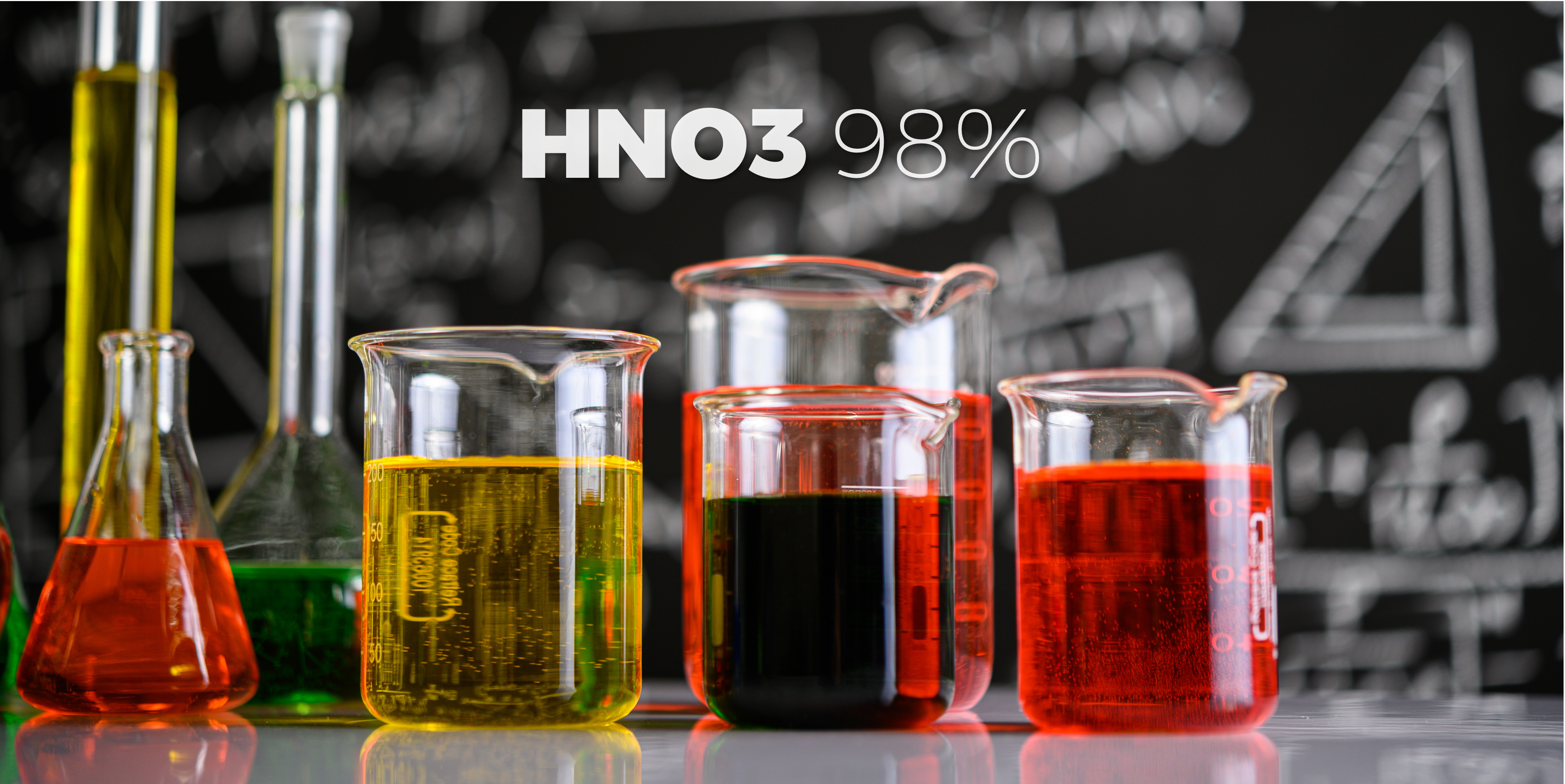Conditions for importing and trading chemicals Nitric acid, with the chemical formula HNO3, 98% concentration (abbreviated as “HNO3 98%”)

A. Legal grounds
- Law on Chemicals dated November 21, 2007 of the National Assembly;
- Decree 113/ 2017/ND-CP detailing and guiding the implementation of a number of articles of the Law on Chemicals dated October 9 2017 by the Government.
B. Customer’s request
Customers expect Khoa Tin to advise on relevant legal regulations to import and trade 98% HNO3 chemicals for companies operating in the Industrial Park.
C. Legal opinion
HNO3 98% is a chemical belonging to:
- The list of hazardous chemicals for which a chemical incident prevention and response plan must be developed is specified in Table 1, Appendix IV ( Attached to Decree No. 113/2017/ND-CP) in case the threshold for the maximum amount of chemicals stored at a given time is attached. from 5,000 (kg) or more.
When customers trading HNO3 98% have the largest amount of inventory at a time of 5,000 (kg) or more, they must develop and appraise a plan to prevent and respond to chemical incidents as prescribed in Clause 1 of this Article. 2 Article 20 of Decree No. 113/2017/ND-CP: “The investor in a project to produce, trade, store and use chemicals contains at least one chemical in Appendix IV to this Decree with the block The largest amount of stock at a time is greater than or equal to the volume threshold specified in this Appendix, a plan for prevention and response to chemical incidents for all hazardous chemicals in which the project is active must be developed. and submit it to line ministries for appraisal and approval before officially putting the project into operation”.
In case of trading in 98% HNO3 chemicals but the largest storage volume at a time is less than 5,000kg, according to the provisions of Clause 1, Article 21 of Decree 113/2017/ND-CP, customers are not required to build develop a chemical incident prevention and response plan, but must develop a chemical incident prevention and response measure and present it at the request of a competent authority.
- The list of chemicals to be declared is specified in Appendix V (Attached to Decree No. 113/2017/ND-CP), according to Clause 1, Article 25 of Decree No. 113/2017/ND-CP:
“Article 25. Chemicals subject to declaration
- The list of chemicals subject to declaration is promulgated in Appendix V to this Decree.”
Thus, when importing 98% HNO3, customers need to declare to the competent authority through the National Single Window Portal as prescribed in Clause 1, Article 26 of Decree No. 113/2017/ND- CP. In case of import and sale of 98% HNO3 with the maximum amount of chemical stored at a time of 5,000 (kg) or more, it is necessary to develop a plan to prevent and respond to chemical incidents. In case of import and trade of 98% HNO3 with the maximum amount of chemical stored at a time below 5,000 (kg), it is necessary to develop Chemical Incident Prevention and Response Measures. In addition, customers need to meet general conditions to ensure safety in chemical business. As follows:
1. Conditions according to general requirements to ensure safety in HNO3 chemical business 98%
According to the provisions of Article 12 of the Law on Chemicals 2007; Article 4, Clause 2, Article 5, Clause 1, Article 6, Decree 113/2017/ND-CP. General requirements to ensure safety in the chemical business of 98% HNO3 include:
1.1. Technical facilities:
- Workshops, warehouses: Satisfying requirements according to national technical standards and regulations, suitable to the nature, scale and technology; There are exits and exits; The ventilation system of factories and warehouses must meet the regulations and standards on ventilation systems; The lighting system must comply with regulations to meet the requirements of chemical production and storage; Electrical equipment in workshops and warehouses must meet standards on fire and explosion prevention and fighting; Floors of workshops and chemical warehouses must be resistant to chemicals, loads, non-slip, with good drainage and collection grooves; Workshops and chemical warehouses must have a table of internal rules on chemical safety, have danger signs suitable to the level of danger of chemicals, and hang them in a conspicuous place; Safety equipment, fire and explosion prevention and fighting, lightning protection, prevention and control of chemical leakage and dispersion and other chemical incidents;
- Technology and equipment: Technical equipment must meet general safety requirements according to national technical standards and regulations, be suitable for chemical types and technological processes, and meet production capacity. business scale. Machines, equipment and supplies subject to strict requirements on occupational safety and health and testing measuring equipment must be inspected, calibrated, calibrated and maintained in accordance with current regulations on machinery inspection. , device;
- Labor protection equipment;
- Environmental protection equipment; Technical equipment must meet general safety requirements according to national technical regulations and standards, be suitable for chemical types and technological processes, and meet production capacity and business scale. Machines, equipment and supplies subject to strict requirements on occupational safety and health and testing measuring equipment must be inspected, calibrated, calibrated and maintained in accordance with current regulations on machinery inspection. , device; waste treatment system;
Transportation; - Table of regulations on chemical safety; signaling system appropriate to the level of danger of chemicals in hazardous chemical production and trading areas. In case a chemical has many different hazardous properties, the warning logo must fully show those dangerous properties.
1.2. Preserve
98% HNO3 is stored separately in warehouses or separate warehouses, must be preserved according to current national standards and technical regulations, ensuring safety and convenience requirements for chemical incident response.
2. Develop a plan for prevention and response to chemical incidents
Before trading in HNO3 98% chemicals, customers must develop a plan to prevent and respond to chemical incidents when the largest volume of HNO3 98% at a time is from 5,000kg as mentioned above and recommended Competent agencies appraise chemical incident prevention and response plans.
2.1. Dossier of request for appraisal of chemical incident prevention and response plan
According to the provisions of Clause 4, Article 20 of Decree 113/2017/ND-CP, an application for appraisal of a chemical incident prevention and response plan includes:
- A written request for appraisal of a chemical incident prevention and response plan, made according to form 03a, Appendix 3 issued together with Circular 32/2017/TT-BCT guiding the Law on Chemicals and Decree 113/2017/ND -CP guidelines for the Law on Chemicals;
- Prepare a plan for prevention and response to chemical incidents, including 09 copies.
2.2. Authority to appraise and approve the Plan
According to the provisions of Clause 2, Article 20 of Decree 113/2017/ND-CP, the agency competent to appraise and approve the chemical incident prevention and response plan belongs to the Chemical Department of the Ministry of Industry and Trade.
2.3. Order and procedures for appraisal and approval of the Plan
According to the provisions of Clause 6, Article 20 of Decree 113/2017/ND-CP, the procedures for appraising and approving the chemical incident prevention and response plan are as follows:
Step 1. Make 01 dossier and send it to the Chemical Department of the Ministry of Industry and Trade by post or directly or through the online public service system.
In case the dossier is incomplete and invalid, within 03 working days from the date of receiving the dossier, the appraisal agency of the Department of Chemicals will notify the customer to supplement and complete the dossier.
After receiving a complete and valid dossier, the appraising agency shall have to organize the appraisal of the Plan. Appraisal of the Plan is carried out through the Appraisal Council.
Step 2. Appraisal Council approves or disapproves the Plan
In case the Plan is not approved, the Customer must rebuild the Plan. Appraisal dossiers and procedures are the same as those for the first time;
In case the Plan is approved or approved with the condition that amendments and supplements are required, the Customer must comply with the requirements stated in the Appraisal Minutes and send a written explanation, 01 electronic and 07 printed copies. The plan has been revised at the request of the Appraisal Council for the appraisal agency;
After receiving the report, the appraising agency shall consider and approve the Plan. In case the Plan is not approved, it must reply in writing, clearly stating the reason.
Step 3. On the basis of the approved Plan, the appraisal agency authenticates on the cover page of the Plan and sends the Decision on Approval together with the Plan to relevant organizations, individuals, agencies and units. local authority to implement the project.
2.4. Time limit for appraisal and approval
According to the provisions of Clause 4, Article 20 of Decree 113/2017/ND-CP, the time limit for appraisal and approval of the Plan is 22 working days from the date the application-receiving agency receives the complete and valid dossier. does not include the time to complete the dossier at the request of the appraisal agency and the appraisal council.
3. Develop measures to prevent and respond to chemical incidents
As mentioned above, in case of import and trade of 98% HNO3 with the maximum amount of chemical stored at a time below 5,000 (kg) it is not necessary to develop a plan for prevention and response to the disaster. chemical incident but only need to develop preventive measures to respond to chemical incidents.
According to the provisions of Clause 2, Article 21 of Decree 113/2017/ND-CP, chemical incident prevention and response measures developed by customers include the basic contents specified in Clause 3, Article 36. of the Law on Chemicals, specifically:
- Identify, localize, and plan regular inspections of high-risk chemical incidents;
- Measures, equipment and response forces in place;
- A plan to coordinate with external forces to respond to chemical incidents.
4. Declare 98% HNO3 chemicals when importing
According to the provisions of Clause 2, Article 25 and Clause 1, Article 27 of Decree 113/2017/ND-CP, before customs clearance for import of HNO3 98%, customers must declare through the National Single Window Portal. The order of import declaration is done as follows:
Step 1: Create an account to access the National Single Window
Step 2: Declare information about imported 98% HNO3
Step 3: The Ministry of Industry and Trade will automatically respond via the National Single Window Portal to customers and customs authorities, the feedback is as evidence of completion of chemical declaration, valid for customs clearance procedures.
Cases exempt from declaration:
According to the provisions of Article 28 of Decree 113/2017/ND-CP, customers are exempted from declaring the import of 98% HNO3 chemicals in one of the following cases:
- Import less than 10 kg/one time import.
- As a raw material for the production of a drug that has a certificate of registration for drug circulation in Vietnam, the raw material for drug production is an active ingredient for drug production. manufactured according to drug registration dossiers that already have a certificate of drug registration in Vietnam.
- As a raw material for the production of plant protection drugs that have obtained a certificate of registration of pesticides in Vietnam.
Above is a letter of advice from Khoa Tin about: “Legal regulations for importing and trading 98% HNO3 chemicals”.
In case customers have unclear issues or need to discuss further, please call us immediately at 0983.533.005 for a free consultation.
Best regards./.
Latest news










